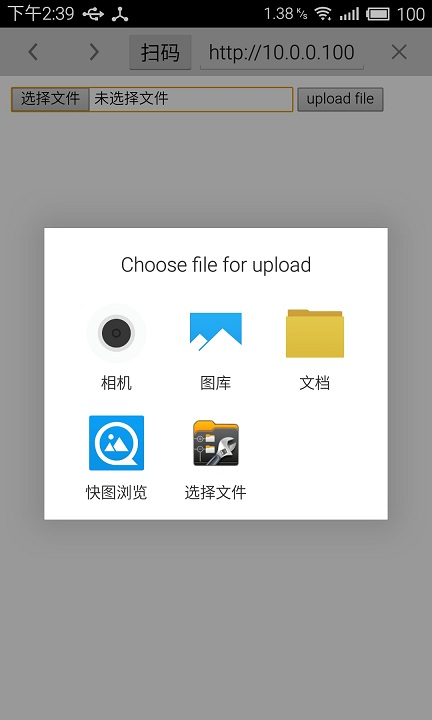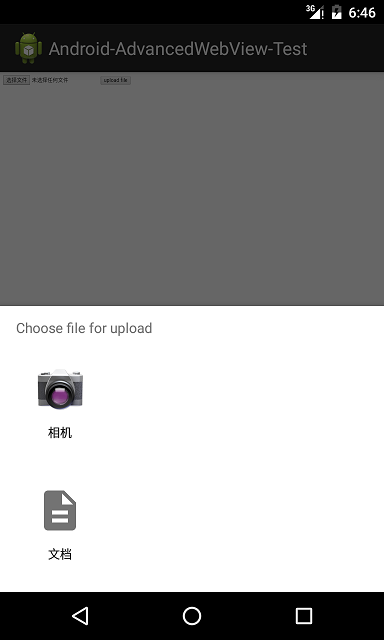原文链接:http://blog.csdn.net/lovelyelfpop/article/details/52815700
默认安卓的WebView显示的网页,其中的文件选择控件<input type="file">是不能选择文件的,点击弹不出文件或图片选择。
其实Google给WebView提供了接口,只要实现这些接口,就可以选择文件了。
搜索了很多,最终发现StackOverflow上的这个答案,是我找到最能满足需求的一个解决方案了。
http://stackoverflow.com/questions/5907369/file-upload-in-webview#24280517
1、支持几乎所有安卓版本,从安卓2.x~7.0
安卓4.4、4.4.1和4.4.2是无法支持的,因为当时Google说WebView上传文件不安全,就去掉了。所以这3个版本没有解决办法。不过现在基本没有这3个系统版本的设备了吧。
4.4.3和4.4.4是支持的
2、支持指定accept="",限制选择文件的类型
如果指定了accept="image/*",那么就会支持选择图片;如果不指定,那就可以选择任何文件。等等。
3、支持拍照上传
指定了accept="image/*",除了支持选择图片,还可以拍照
下面提供InAppBrowser插件的改进:
先上效果图(文件选择控件指定了accept="image/*")
下图是安卓4.4.4的效果
下图是安卓6.0的效果
下图是安卓7.0的效果
1、修改cordova-plugin-inappbrowser\src\android\InAppChromeClient.java
增加成员变量
//added
private CordovaPlugin plugin;
public UploadHandler mUploadHandler;
//added
public InAppChromeClient(CordovaWebView webView, CordovaPlugin plugin) {
super();
this.webView = webView;
this.plugin = plugin;
}
//added all below
// Android 2.x
public void openFileChooser(ValueCallback<Uri> uploadMsg) {
openFileChooser(uploadMsg, "");
}
// Android 3.0
public void openFileChooser(ValueCallback<Uri> uploadMsg, String acceptType) {
openFileChooser(uploadMsg, "", "filesystem");
}
// Android 4.1
public void openFileChooser(ValueCallback<Uri> uploadMsg, String acceptType, String capture) {
mUploadHandler = new UploadHandler(new Controller());
mUploadHandler.openFileChooser(uploadMsg, acceptType, capture);
}
// Android 4.4, 4.4.1, 4.4.2
// openFileChooser function is not called on Android 4.4, 4.4.1, 4.4.2,
// you may use your own java script interface or other hybrid framework.
// Android 5.0.1
@SuppressLint("NewApi")
public boolean onShowFileChooser(
WebView webView, ValueCallback<Uri[]> filePathCallback,
FileChooserParams fileChooserParams) {
String acceptTypes[] = fileChooserParams.getAcceptTypes();
String acceptType = "";
for (int i = 0; i < acceptTypes.length; ++ i) {
if (acceptTypes[i] != null && acceptTypes[i].length() != 0)
acceptType += acceptTypes[i] + ";";
}
if (acceptType.length() == 0)
acceptType = "*/*";
final ValueCallback<Uri[]> finalFilePathCallback = filePathCallback;
ValueCallback<Uri> vc = new ValueCallback<Uri>() {
@Override
public void onReceiveValue(Uri value) {
Uri[] result;
if (value != null)
result = new Uri[]{value};
else
result = null;
finalFilePathCallback.onReceiveValue(result);
}
};
openFileChooser(vc, acceptType, "filesystem");
return true;
}
public class Controller {
final static int FILE_SELECTED = 4;
CordovaInterface getCordova(){ return plugin.cordova; }
}
// copied from android-4.4.3_r1/src/com/android/browser/UploadHandler.java
//
/*
* Copyright (C) 2010 The Android Open Source Project
*
* Licensed under the Apache License, Version 2.0 (the "License");
* you may not use this file except in compliance with the License.
* You may obtain a copy of the License at
*
* http://www.apache.org/licenses/LICENSE-2.0
*
* Unless required by applicable law or agreed to in writing, software
* distributed under the License is distributed on an "AS IS" BASIS,
* WITHOUT WARRANTIES OR CONDITIONS OF ANY KIND, either express or implied.
* See the License for the specific language governing permissions and
* limitations under the License.
*/
class UploadHandler {
/*
* The Object used to inform the WebView of the file to upload.
*/
private ValueCallback<Uri> mUploadMessage;
private String mCameraFilePath;
private boolean mHandled;
private boolean mCaughtActivityNotFoundException;
private Controller mController;
public UploadHandler(Controller controller) {
mController = controller;
}
String getFilePath() {
return mCameraFilePath;
}
boolean handled() {
return mHandled;
}
void onResult(int resultCode, Intent intent) {
if (resultCode == Activity.RESULT_CANCELED && mCaughtActivityNotFoundException) {
// Couldn't resolve an activity, we are going to try again so skip
// this result.
mCaughtActivityNotFoundException = false;
return;
}
Uri result = intent == null || resultCode != Activity.RESULT_OK ? null
: intent.getData();
// As we ask the camera to save the result of the user taking
// a picture, the camera application does not return anything other
// than RESULT_OK. So we need to check whether the file we expected
// was written to disk in the in the case that we
// did not get an intent returned but did get a RESULT_OK. If it was,
// we assume that this result has came back from the camera.
if (result == null && intent == null && resultCode == Activity.RESULT_OK) {
File cameraFile = new File(mCameraFilePath);
if (cameraFile.exists()) {
result = Uri.fromFile(cameraFile);
// Broadcast to the media scanner that we have a new photo
// so it will be added into the gallery for the user.
mController.getCordova().getActivity().sendBroadcast(
new Intent(Intent.ACTION_MEDIA_SCANNER_SCAN_FILE, result));
}
}
mUploadMessage.onReceiveValue(result);
mHandled = true;
mCaughtActivityNotFoundException = false;
}
void openFileChooser(ValueCallback<Uri> uploadMsg, String acceptType, String capture) {
final String imageMimeType = "image/*";
final String videoMimeType = "video/*";
final String audioMimeType = "audio/*";
final String mediaSourceKey = "capture";
final String mediaSourceValueCamera = "camera";
final String mediaSourceValueFileSystem = "filesystem";
final String mediaSourceValueCamcorder = "camcorder";
final String mediaSourceValueMicrophone = "microphone";
// According to the spec, media source can be 'filesystem' or 'camera' or 'camcorder'
// or 'microphone' and the default value should be 'filesystem'.
String mediaSource = mediaSourceValueFileSystem;
if (mUploadMessage != null) {
// Already a file picker operation in progress.
return;
}
mUploadMessage = uploadMsg;
// Parse the accept type.
String params[] = acceptType.split(";");
String mimeType = params[0];
if (capture.length() > 0) {
mediaSource = capture;
}
if (capture.equals(mediaSourceValueFileSystem)) {
// To maintain backwards compatibility with the previous implementation
// of the media capture API, if the value of the 'capture' attribute is
// "filesystem", we should examine the accept-type for a MIME type that
// may specify a different capture value.
for (String p : params) {
String[] keyValue = p.split("=");
if (keyValue.length == 2) {
// Process key=value parameters.
if (mediaSourceKey.equals(keyValue[0])) {
mediaSource = keyValue[1];
}
}
}
}
//Ensure it is not still set from a previous upload.
mCameraFilePath = null;
if (mimeType.equals(imageMimeType)) {
if (mediaSource.equals(mediaSourceValueCamera)) {
// Specified 'image/*' and requested the camera, so go ahead and launch the
// camera directly.
startActivity(createCameraIntent());
return;
} else {
// Specified just 'image/*', capture=filesystem, or an invalid capture parameter.
// In all these cases we show a traditional picker filetered on accept type
// so launch an intent for both the Camera and image/* OPENABLE.
Intent chooser = createChooserIntent(createCameraIntent());
chooser.putExtra(Intent.EXTRA_INTENT, createOpenableIntent(imageMimeType));
startActivity(chooser);
return;
}
} else if (mimeType.equals(videoMimeType)) {
if (mediaSource.equals(mediaSourceValueCamcorder)) {
// Specified 'video/*' and requested the camcorder, so go ahead and launch the
// camcorder directly.
startActivity(createCamcorderIntent());
return;
} else {
// Specified just 'video/*', capture=filesystem or an invalid capture parameter.
// In all these cases we show an intent for the traditional file picker, filtered
// on accept type so launch an intent for both camcorder and video/* OPENABLE.
Intent chooser = createChooserIntent(createCamcorderIntent());
chooser.putExtra(Intent.EXTRA_INTENT, createOpenableIntent(videoMimeType));
startActivity(chooser);
return;
}
} else if (mimeType.equals(audioMimeType)) {
if (mediaSource.equals(mediaSourceValueMicrophone)) {
// Specified 'audio/*' and requested microphone, so go ahead and launch the sound
// recorder.
startActivity(createSoundRecorderIntent());
return;
} else {
// Specified just 'audio/*', capture=filesystem of an invalid capture parameter.
// In all these cases so go ahead and launch an intent for both the sound
// recorder and audio/* OPENABLE.
Intent chooser = createChooserIntent(createSoundRecorderIntent());
chooser.putExtra(Intent.EXTRA_INTENT, createOpenableIntent(audioMimeType));
startActivity(chooser);
return;
}
}
// No special handling based on the accept type was necessary, so trigger the default
// file upload chooser.
startActivity(createDefaultOpenableIntent());
}
private void startActivity(Intent intent) {
try {
mController.getCordova().startActivityForResult(plugin, intent, Controller.FILE_SELECTED);
} catch (ActivityNotFoundException e) {
// No installed app was able to handle the intent that
// we sent, so fallback to the default file upload control.
try {
mCaughtActivityNotFoundException = true;
mController.getCordova().startActivityForResult(plugin, createDefaultOpenableIntent(),
Controller.FILE_SELECTED);
} catch (ActivityNotFoundException e2) {
// Nothing can return us a file, so file upload is effectively disabled.
Toast.makeText(mController.getCordova().getActivity(), "File uploads are disabled.",
Toast.LENGTH_LONG).show();
}
}
}
private Intent createDefaultOpenableIntent() {
// Create and return a chooser with the default OPENABLE
// actions including the camera, camcorder and sound
// recorder where available.
Intent i = new Intent(Intent.ACTION_GET_CONTENT);
i.addCategory(Intent.CATEGORY_OPENABLE);
i.setType("*/*");
Intent chooser = createChooserIntent(createCameraIntent(), createCamcorderIntent(),
createSoundRecorderIntent());
chooser.putExtra(Intent.EXTRA_INTENT, i);
return chooser;
}
private Intent createChooserIntent(Intent... intents) {
Intent chooser = new Intent(Intent.ACTION_CHOOSER);
chooser.putExtra(Intent.EXTRA_INITIAL_INTENTS, intents);
chooser.putExtra(Intent.EXTRA_TITLE,
"Choose file for upload");
return chooser;
}
private Intent createOpenableIntent(String type) {
Intent i = new Intent(Intent.ACTION_GET_CONTENT);
i.addCategory(Intent.CATEGORY_OPENABLE);
i.setType(type);
return i;
}
private Intent createCameraIntent() {
Intent cameraIntent = new Intent(MediaStore.ACTION_IMAGE_CAPTURE);
File externalDataDir = Environment.getExternalStoragePublicDirectory(
Environment.DIRECTORY_DCIM);
File cameraDataDir = new File(externalDataDir.getAbsolutePath() +
File.separator + "browser-photos");
cameraDataDir.mkdirs();
mCameraFilePath = cameraDataDir.getAbsolutePath() + File.separator +
System.currentTimeMillis() + ".jpg";
cameraIntent.putExtra(MediaStore.EXTRA_OUTPUT, Uri.fromFile(new File(mCameraFilePath)));
return cameraIntent;
}
private Intent createCamcorderIntent() {
return new Intent(MediaStore.ACTION_VIDEO_CAPTURE);
}
private Intent createSoundRecorderIntent() {
return new Intent(MediaStore.Audio.Media.RECORD_SOUND_ACTION);
}
}别忘了顶部Import
//added
import org.apache.cordova.CordovaPlugin;
import org.apache.cordova.CordovaInterface;
import android.annotation.SuppressLint;
import android.app.Activity;
import android.content.ActivityNotFoundException;
import android.content.Intent;
import android.net.Uri;
import android.os.Environment;
import android.provider.MediaStore;
import android.webkit.ValueCallback;
import android.widget.Toast;
import java.io.File;
2、修改cordova-plugin-inappbrowser\src\android\InAppBrowser.java
增加成员变量
//added
private InAppChromeClient chromeClient;
// WebView
inAppWebView = new WebView(cordova.getActivity());
inAppWebView.setLayoutParams(new LinearLayout.LayoutParams(LayoutParams.MATCH_PARENT, LayoutParams.MATCH_PARENT));
inAppWebView.setId(Integer.valueOf(6));
//inAppWebView.setWebChromeClient(new InAppChromeClient(thatWebView));//注释掉这一句
//加上下面2句
chromeClient = new InAppChromeClient(thatWebView, InAppBrowser.this);
inAppWebView.setWebChromeClient(chromeClient);
WebViewClient client = new InAppBrowserClient(thatWebView, edittext);
@Override
public void onActivityResult(int requestCode, int resultCode, Intent intent) {
if (requestCode == InAppChromeClient.Controller.FILE_SELECTED) {
// Chose a file from the file picker.
if (chromeClient != null && chromeClient.mUploadHandler != null) {
chromeClient.mUploadHandler.onResult(resultCode, intent);
}
}
super.onActivityResult(requestCode, resultCode, intent);
}至于iOS版本的,最新的InAppBrowser插件1.5.0+已经支持选择文件了(1.5.0以前的版本不行,有bug)




























 598
598

 被折叠的 条评论
为什么被折叠?
被折叠的 条评论
为什么被折叠?










